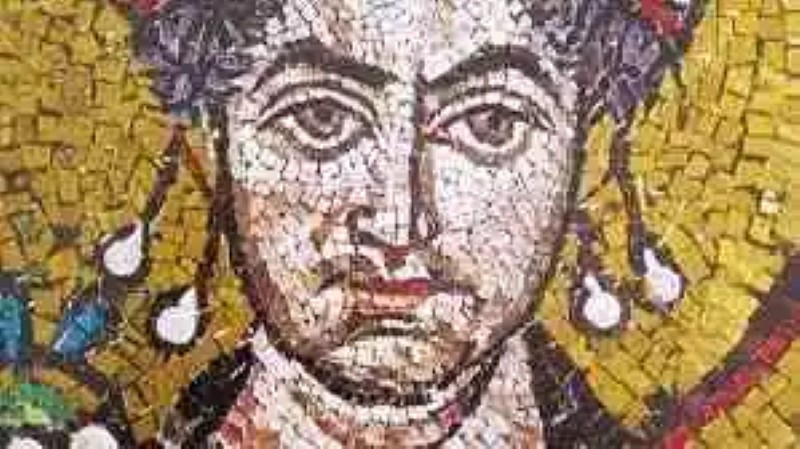Flavius Petrus Sabbatius Iustinianus, better known as Justinian I (Tenius, Macedonia, 11 May 483 A.D. – Constantinople, 13 November 565 A.D.). Political leader, who came to be crowned Roman Emperor, being known as the “last of the Romans”.

Due to his attempts to recover the greatness and territories enjoyed by Rome until the time of Theodosius I, for which he began the period historically known as renovatio imperii romanorum, marked by great military battles and the construction of large buildings.
He is one of the most important figures of antiquity and the last emperor born under the Latin language. He is also revered as a saint by the Orthodox church and some Lutheran groups, being his day on November 14, being also listed as one of the most important emperors of the Stories.
Early life and assumption to the throne
Justinian I was born in the ancient city of Tauresius, located in Macedonia, on May 11, 483 A.D., into a very humble family of Thracian or Ilyric origin, whose mother tongue would have been Latin.
His mother, Vigilantia, was apparently the sister of Justin, a member of the Excubitors, an imperial guard, who became emperor in 518 A.D. Early on, Justino adopted his nephew Flavius Petrus, taking him with him to Constantinople, where he took care to provide him with a good education.
In gratitude, Flavius Petrus took the name Justinian. He studied jurisprudence, history and theology,and is believed to have served for a time in the troops of the Excubitors.
He served as special support to his uncle Justino in his assumption to the throne as emperor in 518 A.D., after the death of Emperor Anastasius I, who had no children. Since then he remained at his side, serving as a confidant, and some say that also as ruler.
In 521 he was appointed As Consul. In 525 A.D. Justiniano married Theodora, who would be one of his main confidants and collaborators, until his sudden death in 548 A.D.
On 1 April 527 A.D. he was named by Justin himself as Cooemperador. After his uncle’s death on August 1, 527, Justinian I assumed the post of Emperor altogether.
Government
His mandate was distinguished as a highly active government. He himself was known as “the emperor who never sleeps.” He also set the tone, surrounded in his government with large-capacity people, regardless of their aristocratic origin or not, establishing a new regime of meritocracy.
However, Justinian’s first measures led to a large opposition movement, which led to the Niká riots in 562 A.D., with the aim of overthrowing Justinian I, ending the total repression of the rebels,in which about thirty thousand citizens died, while twenty-eight of the former emperor Anastasius’s nephews were also executed, thanks to pressure from Theodora.
Constantinople was devastated, giving Justinian the opportunity to build new constructions, including the Church of Hagia Sophia.
Military campaigns
Also, one of the most significant features his government was the development of large military campaigns, whose objective was to recover the lost territories of the great Roman empire during the 5th century. Unlike other emperors and leaders, Justinian didn’t participate personally, for which he entrusted his general Belisario.
In this sense, the first war they faced was against the Sasanyid Empire, whose conflicts with Constantinople had inherited them from Justino’s command.
Finally, in 532, Justinian managed to sign a peace treaty, known as the Perpetual Peace, with the new King Cosries I, thus sealing peace on the eastern limits of the empire, and turning his attention to the West. In 534, after an arduous military campaign, they managed to take the ancient Roman territories, located in North Africa from the vandal kingdom.
The following year the empire of Justinian I waged the fight against the Ostrogoth kingdom, who had seized Italy, in order to recover these lands for the Byzantine empire, in order to restore the Roman empire.
In 540, the Byzantine empire achieved its victory in this conflict, called the Gothic War. However, it was not until 554 A.D. that Italy was reintegrating from the Roman Empire.
In 541 A.D., his empire marched against the Visigothic kingdom, which was held by the province of Spania, in the southeastern part of the Iberian Peninsula, achieving full victory and the recovery of the territory finally in 554 A.D., gaining full control to the shores of the Mediterranean.
Corpus Iuris Civilis
Justinian is also remembered for being a propellant on the codification of Roman law, which was embodied in 529 within the Corpus Iuris Civilis, made up of imperial laws, collected by the JustinIan Code; the legal opinions included in the Pandectas and the book Institutions, book for the teaching of law.
At present, it is still studied by legal specialists, as the first step towards the establishment of a legal culture, through the rationalization of laws. He also achieved the religious unification of his empire.
Final years
However, he was not a popular emperor, especially from 542 A.D. when his territory was hit by a strong epidemic, which is presumed to be an outbreak of black plague, which resulted in the impoverishment of the population.
He died in Constantinople, 13 November 565 A.D., news that was greeted with joy by the people. Before long Byzantium lost most of the reclaimed territories, becoming definitely an eastern empire. Despite his reign, however, he had a global impact, writing a new chapter for the Byzantine Empire and the Orthodox Church.
Image source: classic-castle.com
Phoneia.com (July 31, 2019). Justinian I Biography. Recovered from https://phoneia.com/en/education/justinian-i-biography/